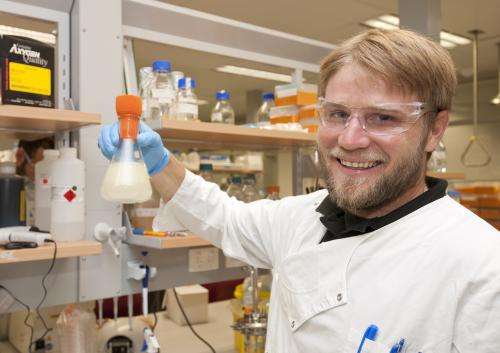Future fuels will come in orange flavour, but researchers have to teach yeast to make it

Queensland researchers are persuading baker's yeast to produce orange-flavoured renewable jet fuel from sugar.
Mr Timothy Brennan and his colleagues at the University of Queensland's Australian Institute for Bioengineering and Nanotechnology have helped genetically-engineered yeast to evolve to make an oil called limonene, which is found naturally in lemons and oranges, and also happens to be an efficient jet fuel.
They've worked out how to get the yeast to make more oil without killing itself in the process.
It's an important step in scaling up biofuel production so that it can become a serious alternative to traditional fossil fuels.
"When you open an orange, what you're smelling is limonene – it's a hydrocarbon that has excellent jet-fuel properties and recently outperformed traditional jet fuel in a model aircraft," says Tim, the Queensland winner of Famelab Australia.
"We can take genes from oranges or lemons and assemble them in yeast to turn them into tiny limonene factories, which eat sugar and spit out orange-flavoured jet fuels," he says.
While there are plenty of researchers already producing small amounts of yeast-derived biofuels around the world, one common limitation is the fact that production volumes are limited by the toxicity of the fuel. Tim and his colleagues have made two important steps forward.
The major stumbling block is that too much limonene is toxic to yeast cells, and this limits how much fuel the yeast cells can produce before it kills them.
"When you buy household cleaning products that smell like lemons or oranges, those flavour compounds aren't just there to smell nice – they actually help kill bugs, and they kill yeast too," Tim explains.
But Tim and his colleagues have worked out how to help the yeast survive the toxic conditions to produce greater volumes of the fuel.
They've redesigned the bioreactor so the fuel is removed immediately after being produced by the yeast. This has allowed the same yeast to tolerate up to 700 times more fuel than it would in a traditional bioreactor.
And they're also altering the genes of the yeast to help it withstand higher levels of limonene.
"By changing only a single gene, I can improve the cells' resistance to the fuel, so it can stand to produce more of it. But finding that gene wasn't easy – I had to use biology's oldest tool, adaptive evolution, to help me get there," says Tim.
"I couldn't wait for the yeast cells to evolve naturally on their own, so I sped up evolution in the lab. Each day I'd challenge them with a little more limonene than they had the day before. This constant environmental pressure ensured that only the fittest cells survived each day. Two months later I isolated a yeast strain that was much more resistant than the one I started with."
Tim has just completed his PhD with The University of Queensland's Australian Institute for Bioengineering and Nanotechnology (AIBN).
He's part of a team working with Boeing and Virgin to come up with an alternative to petroleum-based fuels.
FameLab is a global science communication competition for early career scientists. Tim was the winner of the Queensland state competition, and was runner-up at the national final in May.
Provided by Science in Public


















